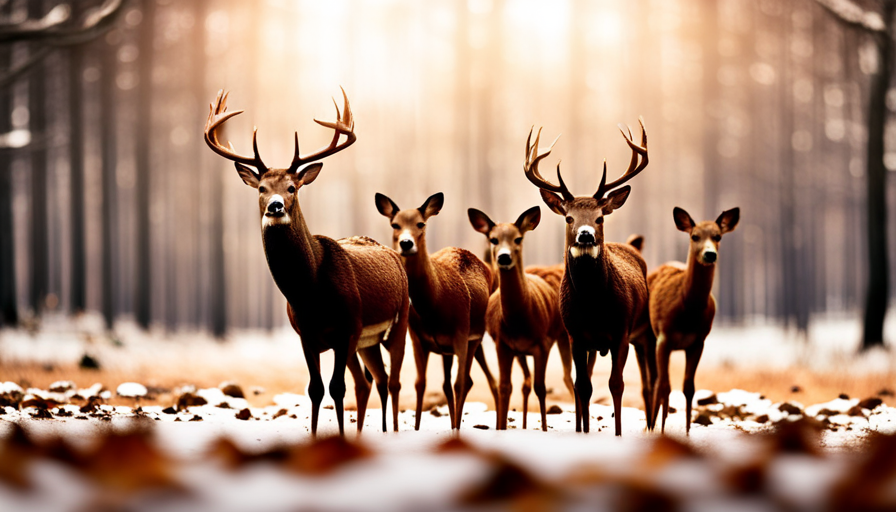During the winter months, deer face significant challenges in finding enough food to meet their nutritional needs. This can lead to malnourishment, weakened immune systems, and other health issues. In response, many people choose to provide supplemental food for deer to help them survive the harsh winter conditions. However, it is important to understand what deer eat in the winter and the regulations surrounding feeding them.
This article aims to provide a comprehensive overview of the deer diet in winter, including what foods are best to feed and what should be avoided. Additionally, we will examine the feeding rules and regulations in the United States and Canada. By understanding the dietary needs of deer and the best practices for feeding them, we can help ensure their survival and promote healthier populations.
This article is based on scientific research and aims to provide a factual, informative guide for those interested in providing supplemental food for deer in the winter.
What Do Deer Eat?
In terms of deer diet during winter, they primarily consume woody browse such as leaves, berries, saplings, bulbs, and buds. This type of food is high in fiber and low in energy, which helps deer maintain their body temperature during the cold season.
In addition, deer may occasionally feed on lush forage if it is available, such as kale, radish, turnips, apples, and cabbage. They also consume hundreds of plant species, fruits, and some vegetables, with corn being their favorite treat. Other food items that deer enjoy include blackberries, greenbriers, honeysuckle, grapevines, acorns, pears, canola, cauliflower, sugar beets, and more.
However, it is important to note that feeding deer consistently is not recommended, as they can become dependent on human-provided food and may suffer from health issues as a result.
Deer have seasonal food preferences, and their diet can vary depending on the region they live in. While a supplemental diet can help them during winter, it is important to avoid changing their food too quickly to prevent rumen acidosis, a potential disease that can occur if fed incorrectly.
Moreover, feeding regulations for deer vary depending on the state or region. Some states permit feeding deer, while others discourage or prohibit it. It is therefore crucial to know the laws and regulations in your area to avoid disrupting the usual eating habits of deer and maintain their overall health.
Feeding Regulations
Feeding regulations for deer vary by state and region, and it is important to be aware of the specific laws and restrictions in your area to avoid disrupting their natural eating habits. Some states permit feeding deer, while others discourage or prohibit it. Similarly, in Canada, feeding deer is allowed in some regions but not in others. It is crucial to check restrictions in your area as regulations can change, and smaller municipalities may have stricter rules.
Feeding deer consistently is not recommended, and it is unnecessary in some areas. However, supplemental diet can help in winter, but changing foods quickly should be avoided as it can lead to rumen acidosis, a potential disease in winter if fed incorrectly.
It is crucial to know the laws and regulations in your area to avoid any negative impact on deer’s health and behavior. Therefore, it is recommended to consult with local wildlife authorities to ensure that you are feeding deer safely and legally.
Avoiding Rumen Acidosis
Preventing rumen acidosis in deer during winter requires careful consideration of their dietary needs and potential health risks. Rumen acidosis is a metabolic disorder that occurs when the pH level in the rumen, the first compartment of the deer’s stomach, drops too low.
This can be caused by an overconsumption of carbohydrates, particularly grains, that ferment too quickly and produce excessive amounts of acid. In winter, deer may be at risk of rumen acidosis if they are fed diets that are too rich in grains or other high-carbohydrate foods.
To avoid rumen acidosis, it is important to provide deer with a balanced diet that is high in roughage and low in grains. This can include woody browse, such as leaves and bark, as well as fruits, nuts, and other vegetation.
Supplemental feeding may be necessary in winter when natural food sources are scarce, but it is important to introduce new foods gradually to prevent any sudden changes in the deer’s diet. Additionally, feeding stations should be monitored regularly to ensure that they are not becoming overcrowded or contaminated with mold or other toxins that can also contribute to rumen acidosis.
By following these guidelines, deer managers can help ensure the health and well-being of their herds during the winter months.

